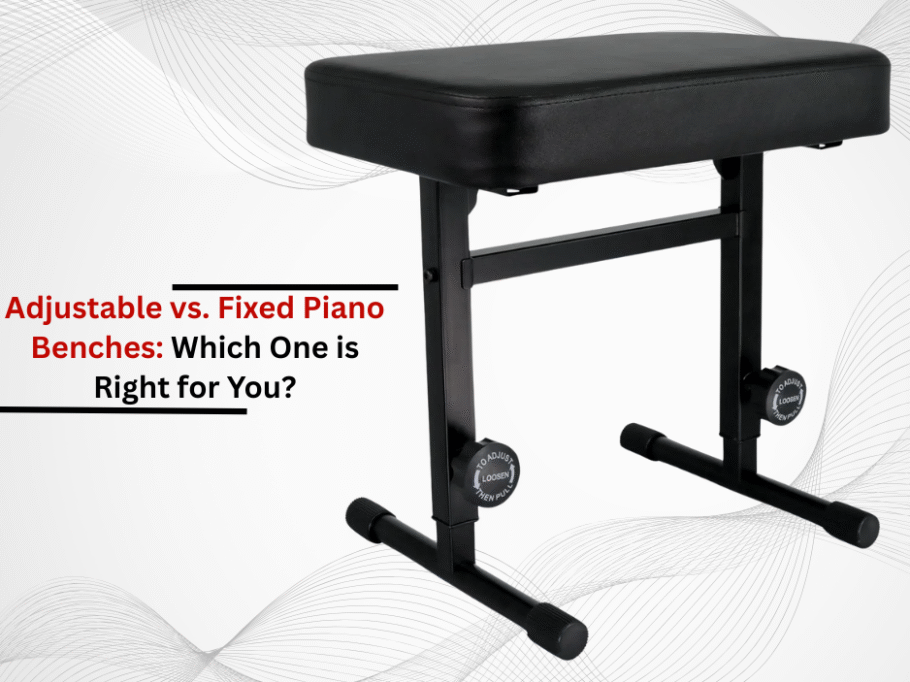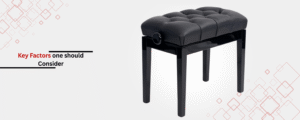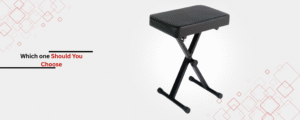A piano bench is more than simply an item of furniture to sit on while playing the piano; it shapes one’s posture and how comfortable they are while executing technical moves. The differences between adjustable and fixed-height benches often depend on the style of playing, the physical requirements of the user, and practicality in the long run. While adjustable benches provide customization options for multiple users, fixed benches are simple and stable. In this article, both types will be analyzed alongside their ergonomic advantages, material options, and overall fit for specific pianists. Covering these angles will help guide choices tailored to personal preferences and performance objectives.
To dive deeper, Read, Cheap vs. Expensive Keyboard Benches: Is Price a Factor?
Key Factors to consider before purchasing a Piano Bench
Ergonomics and posture:
As one of the key components of ergonomics, posture has a significant impact on fatigue, increasing it significantly. This becomes true while practicing for prolonged periods, be it playing or using legato. Regarding the use of the piano, posture is especially important, along with positioning the seat with respect to the keyboard. Benches with adjustable height allow for setting tailor-adjusted height so that forearms rest parallel to the keyboard, which ensures neutral wrist placement. Unlike adjustable ones, fixed-height benches lack height flexibility and consequently may need cushions or extra movement to achieve perfect alignment. This becomes crucial when dealing with counterparts who do not possess average height proportions.
Flexibility and User Requirements:
For multi-level households or music schools, adjustable benches are great for shared spaces as they accommodate varying heights. Fixed benches, however, are a favorite among solo pianists who prefer a consistent setup. It’s often less stressful for the user to maintain a fixed model as there are no moving parts, but there is little flexibility.
Material and Durability:
Both-style benches vary in material from hardwood to steel. The construction of adjustable benches with mechanical components such as hydraulic lifts or spindle systems tends to be more robust due to the need for greater endurance. However, without these mechanisms, fixed benches tend to place more emphasis on traditional craftsmanship and aesthetic harmony with classic pianos.
Budget and Longevity:
Because of their less intricate design, fixed benches tend to be more affordable. On the other hand, while adjustable models have a higher upfront cost, they tend to have greater long-term value for parents of growing musicians or evolving needs. In both categories, reinforced joints and high-density padding are crucial indicators of durability.
Adjustable Piano Benches: Pros and Cons
Advantages:
Every pianist, regardless of age and size, can eliminate the possibility of repetitive strain injuries with ergonomic height customization. Such benches can help active performers who use multiple instruments and need specific posture placement. Advanced memory lock and silent adjustment designs allow modern sculpted benches to change effortlessly.
Drawbacks:
Adjustable features add mechanical parts that increase weight and require maintenance, not to mention the failure of stick or wobbling mechanisms that come with low-quality construction. Budget-friendly buyers might also be discouraged due to the higher initial cost.
Fixed Piano Benches: Pros and Cons
Advantages:
Traditional-styled pianos and their fixed benches glamorous simplicity and matching finishes add stubborn appeal. Non-mechanical pianos are generally lighter and easier to carry. For a fixed model, the sturdy structure guarantees strong underlining support for the preferred seating position.
Drawbacks:
Those sitting below standard height might require external disrupting stability cushions prone to unfit flexibility. Multi-user environments are also off-limits as fixed benches lack adjustability.
Which one Should You Choose?
Adjustable Benches Are Ideal For:
- Music studios with a wide diversity of student profiles.
- Growing kids or families with multiple players.
- Specialists needing accuracy in body mechanics for complex procedures.
Fixed Benches are Ideal for:
- Maintenance-free budgets.
- A solo pianist that prefers sitting on the bench.
- Pianists with a keen eye for space aesthetic harmonization.
Conclusion
Whether the preference is an adjustable or fixed piano bench will always depend on ergonomic considerations, versatility, and budget. While adjustable models are tailored to support dynamic environments, fixed benches offer dependable, ageless convenience. Brands such as Gleam, 5 Core, On Stage, and Donner are catering to the needs of both categories within this undying market. The evolution of piano accessories such as eco-friendly materials or smart ergonomics technology comes in handy; however, comfort and functionality will always rule supreme. By balancing personal needs alongside the advantages of each bench type, pianists can be sure that their seating choice optimally enhances performance and enjoyment.



